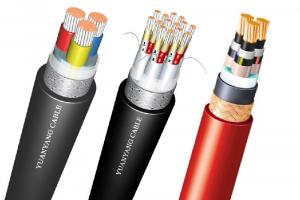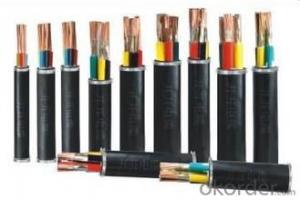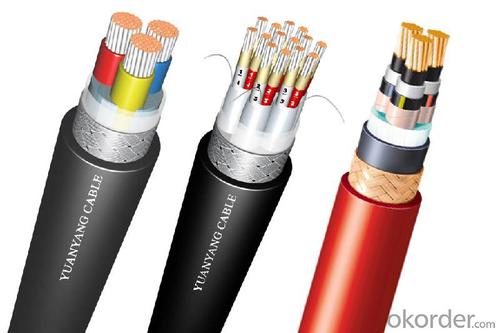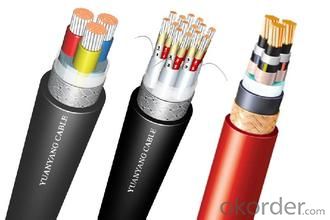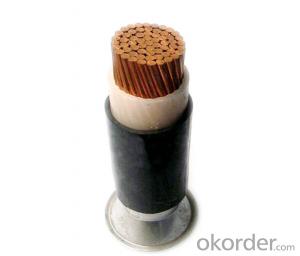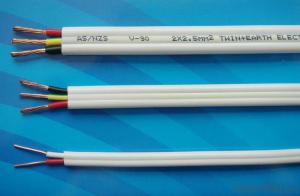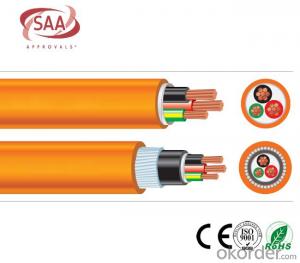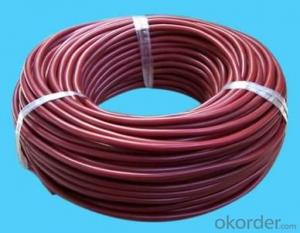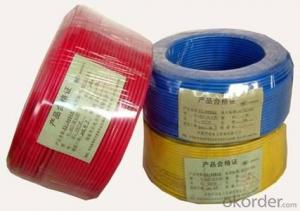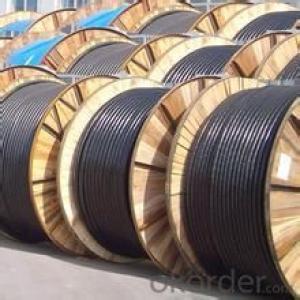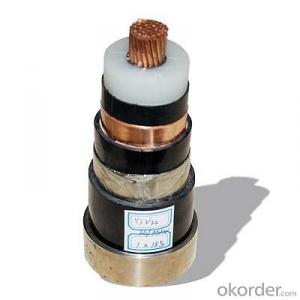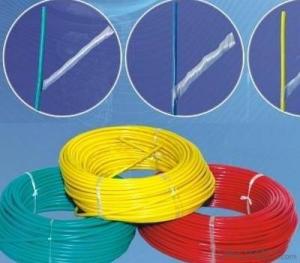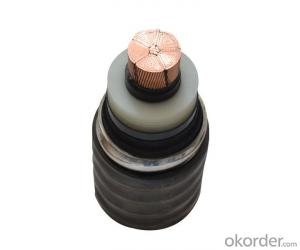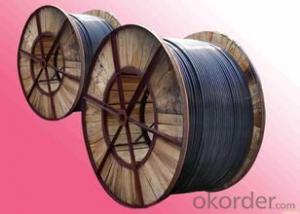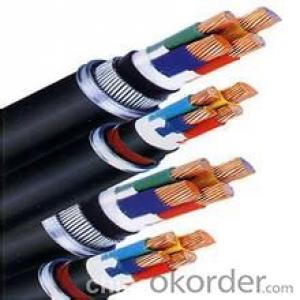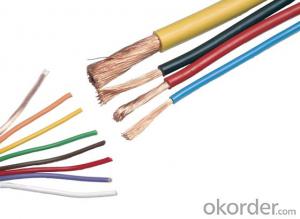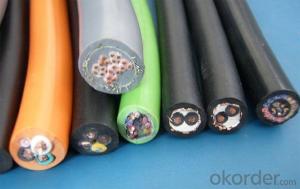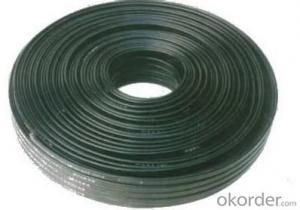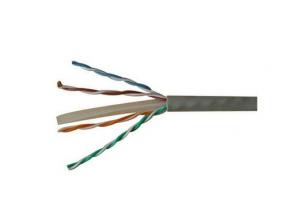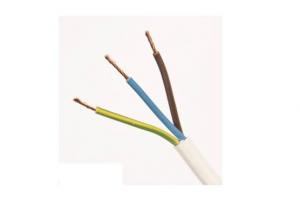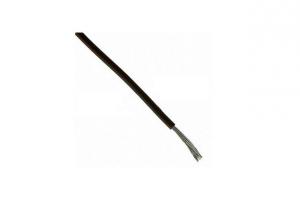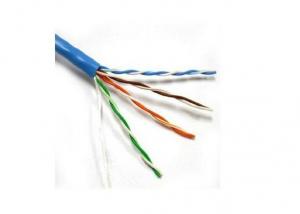Low Voltage(0.6~1kV) PVC insulated electrical power cable
- Loading Port:
- China main port
- Payment Terms:
- TT or LC
- Min Order Qty:
- 100 m
- Supply Capability:
- 20000 m/month
OKorder Service Pledge
OKorder Financial Service
You Might Also Like
Low Voltage(0.6~1kV) PVC Insulated Electrical Power Cable
1. Type, Designation and Application
Type | Designation | Application | |
Cu | Al | ||
VV | VLV | PVC insulated PVC sheathed power cable | Suitable for indoor, channel, conduit. Unable to bear mechanical stress. |
VY | VLY | PVC insulated PE sheathed power cable | |
VV22 | VLV22 | PVC insulated steel-tape armored PVC sheathed power cable | Installed in underground, can bear mechanical stress, but cannot endure large pulling force. |
VV23 | VLV23 | PVC insulated steel-tape armored PE sheathed power cable | |
VV32 | VLV32 | PVC insulated thin steel-wire armored PVC sheathed power cable | Can be installed in vertical well, and bear large mechanical pulling force. |
VV42 | VLV42 | PVC insulated steel-wire armored PVC sheathed power cable | |
VV33 | VLV33 | PVC insulated thin steel-wire armored PE sheathed power cable | |
VV43 | VLV43 | PVC insulated steel-wire armored PE sheathed power cable | |
Note: According to customers’ requirements we can produce flame retardant, fire proof, termite resistant, LSOH and low smoke low halogen, etc.
2. Range of Production
Type | No. of cores | Rated Voltage 0.6/1kV | |
Cu | Al | Nominal cross-section (mm2) | |
VV VY | VLV VLY | 1 | 1.5~630 |
VV22 VV23 | VLV22 VLV23 | 10~630 | |
VV VY | VLV VLY | 2 | 1.5~240 |
VV22 VV23 | VLV22 VLV23 | 4~240 | |
VV32(42) VV33(43) | VLV32(42) VLV33(43) | 4~240 | |
VV VY | VLV VLY | 3 | 1.5~300 |
VV22 VV23 | VLV22 VLV23 | 2.5~300 | |
VV32(42) VV33(43) | VLV32(42) VLV33(43) | 4~300 | |
VV VY | VLV VLY | 4 3+1 | 1.5~300 |
VV22 VV23 | VLV22 VLV23 | 2.5~300 | |
VV32(42) VV33(43) | VLV32(42) VLV33(43) | 4~300 | |
VV VY | VLV VLY | 5 4+1 3+2 | 1.5~300 |
VV22 VV23 | VLV22 VLV23 | 2.5~300 | |
VV32(42) VV33(43) | VLV32(42) VLV33(43) | 4~300 | |
FAQ
Q: How’s your service?
A:1. Offer customers 24/7 service, whenever you need us, we are always here for you.
2. Immediate response. Your any inquiry will be replied within 24 hours.
3. Support small order quantity, for the first time cooperation customers, we can send you less quantity for trial order.
4. Support third party inspection company to inspect and check the quality and quantity before delivery.
Picture
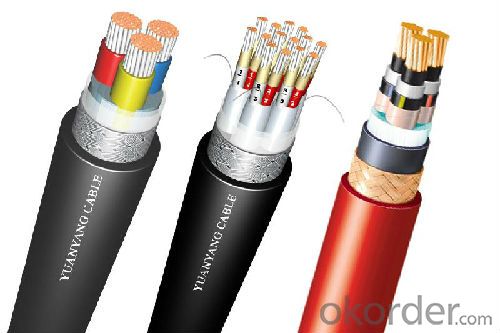
- Q: I'm 13, and I know a lot about electrical wiring. I've been reading home improvement/wiring books since I was 9, and I've also been practicing hooking things up since then. There's a few electrical things around the house that I know are wrong and I would like to fix them myself. I know exactly what to do, what parts to buy, what tools to use, and which circuit breakers to turn off. My dad is going away on business for most of the week, and I would like to surprise him when he gets home on Friday.I also want to be an electrician when I grow up.
- A few things: a) The first time you work on wiring, live or dead, you need to do it with hands-on supervision. No matter how well you might think you are doing or how much practice you have had, you are messing with stuff that can kill or burn. That is the absolute bottom line. b) This means either someone will be there as you do the work, or someone comes in and makes sure that the correct breaker(s) are off, and that your work area is safe - then comes back in when you are done and checks everything before you apply power. c) And, pretty much everyone starting out should have - and be familiar with - a good volt-ohm meter and a very good one-point tester. Tester first! The life you save may be your own. This has nothing at all to do with your age - at 13 you are certainly strong enough and probably intelligent enough to do and grasp the basics. But it has everything to do with 'habit and instinct' - that is safe habits and safe instincts around electricity and a full understanding of what is going on. Why is it, do you think, that electricians have a 2-4 year apprenticeship program before they are allowed the journeyman title? Find yourself an Elmer (The term Elmer--meaning someone who provides personal guidance and assistance) and acquire some confidence before launching out on your own.
- Q: going to roll out attic insulation between the ceiling joists. what do I do when I come across wires that go through the joists? Can I roll the insulation over the wires or should I cut it and leave the wire exposed and start the roll again on the other side of the wire?
- There are some people that shouldn't give advise if they don't know what they are talking about. Please, please don't ever cover an electrical wire with insulation. Jim W is right on! Heat will destroy electrical wire. The NEC's acceptable method of workmanship manner is to (actually) take the time and PULL the insulation under the wire.
- Q: Whether the wire tube is connected to the electrical bridge can be connected to the bottom of the bridge
- RVVP2 * 0.75 * 10 is the communication line is a kind of power cable shielded wire, 0.75 square line
- Q: I understand that buisnesses like vonage, and Comcast do not repair telephone wiring(the actual physical wiring outside) is this correct?There was an accident on our property severing the phones lines. The reason I ask, is because the electrician said, if THEY say I have to fix it. Who is they?
- Question: Is electrician the one who repairs the telephone wiring? Answer: HELL NO!! Sparky may be good for electrical wiring, but they do not know telephone wiring and *cause* problems for telephone repairmen when they try. Not to mention you are asking about inside wire. Judge I rot in Hell Green gave your inside wiring to for you and you can play with your own inside wire, or get a Sparky to screw it up, or call an ex-telco technician to run and/or repair ir, or get it done correctly by the Telephone Company technician's. But you said OUTSIDE wire. Outside wire, the big cables along the utility poles, span and/or pole terminals, the drop wire from the pole to your house, *and* the protector, now called a Network Interface Device (NID) is actually and legally belongs to the Telephone Company -- ATT, Verizon, whatever owns where you live. It is *illegal* for you or vonage or Comcast or a electrician to work on our wiring. Not to mention they don't have the wire, terminals, tools or especially the knowledge to repair drops and outside wire. Call your local telephone company and tell them that *their* wire is on the ground and to get it fixed. If the person from the phone from India cannot understand what you are talking, stop a real telephone technician (you know cause their van/truck says ATT or whatever) and tell them.
- Q: i broke my phone they only way i can fix it is if i know how to reconnect those really paper thin, tape like wires.
- The paper thin wires you describe is called a flex-circuit. For consumer electronics, sometimes the ends are just plated and plug into a connector. Look for a connector (probably black) that the flex-circuit would plug into. Otherwise, have it serviced.
- Q: How is the electrical wiring configuration for North America differs from that in Bratain/Western and Eastern Europe,Latin America Asia/Japan and Australia/Pacific?
- The USA and most of North America uses 60 hertz and 120/240 volts. Most of the rest of the world uses 50 hertz and 240 volts. Small differences in voltage are common from place to place. Hertz or frequency might also vary a little.
- Q: We used a few people together with a router, I do not access the Internet, they are good! As long as I am on the Internet, one will appear network cable is not plugged in, and instantly automatically connected, for a while will be like to restart the cat! We began to think that the virus is the reason, but with anti-virus software is not checked out, had the entire disk formatted after the system, and then the normal use of a period of time, and soon there are old problems! I have installed several times the system, I feel is not a virus problem, please prawn a lot of help! Thank you! Question added: I may not have made clear, as long as I am an Internet, we can not, we will show a few computers will not plug the network cable immediately and automatically connected! I am not on, everyone is normal! Many say that the router is the problem, I think it is not right! Because as long as I am not on, several other computers will not appear this problem, can be normal online! More
- Crushed wire, crimping when there is no skin, directly with the puncture method, a large current so. This line of production time, we must first dial the skin, and then pressure to ensure that the wire core and the joints in direct contact, but also to choose a qualified enough thickness of the joints, you burn this, one is the pressure line, one is the plug and Your power supply D4 plugs are not in touch. Ground board everywhere, you can share the current, but enhance the 12V only from this line to go, so the current is larger than imagined, and once the virtual happen, it will be rapid heat, so that contact is more false. I suggest you go to the regular boss to send the conversion line, when the folder with your computer power which connector, to restore the tightness.
- Q: an electrical current through a copper wire A) creates a magnetic field around the wire B) creates magnetic poles in the wireC) magnetizes the wireD) does not create a magnetic field
- Answer is A Explaination: If you pass current through a straight wire, magnetic field is formed around the wire in the form of circular rings (could affect compass or metal fillings nearby). On the other hand, you're passing current through a circular spring-like thing (commonly, a coil) called solenoid, magnetic field is produced along its axis. Simply you could keep in mind that Magnetic field is produced by moving charges (current). This is an observed phenomena and it's explained by Maxwell.
- Q: I recently came across a big spool of rubber/plastic insulated electrical wiring. I cut into the metal with my knife and saw that it had an orange tint to it. I was excited because I thought it was copper but after I burned it and took it to a scrap yard the guy there stuck a magnet to it and said it wasn't copper. because it stuck to the magnet. So it's been about two months now and there's orange rust on it like Iron. but I know what steel wire looks like. This has that distinct copper orange in it but it's magnetic. Help me. I'm so angry and confused.
- possibly nickel/copper alloy used for heating elements (low temp) as it is insulated look up constantan wire
- Q: I need to run the following:2 x 50 watt filter2 x 500 watt heaterAnd the place that I need to run it is about 300 feet away. What gauge electrical cord do I need???Thanks in advance!
- never use 14gauge wire for your 300foot run it would be best to use 10 gauge wire my guess is that this is for a pool or spa . and it would be safe to use the small weatherproof electric breaker panel right close to your equipment and use th
Send your message to us
Low Voltage(0.6~1kV) PVC insulated electrical power cable
- Loading Port:
- China main port
- Payment Terms:
- TT or LC
- Min Order Qty:
- 100 m
- Supply Capability:
- 20000 m/month
OKorder Service Pledge
OKorder Financial Service
Similar products
Hot products
Hot Searches
Related keywords
